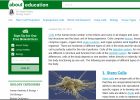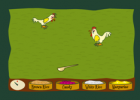Cargando...
Recursos educativos
-
Nivel educativo
-
Competencias
-
Tipología
-
Idioma
-
Tipo de medio
-
Tipo de actividad
-
Destinatarios
-
Tipo de audiencia
-
Creador
-

Answer. Amphibians and reptiles
EduBook Organización
- 2350 visitas
Remember what you have studied in this section and answer the questions: Where do amphibians live? Why is the skin of amphibians moist and slimy? How do reptiles move from place to place?
-

Think about it. The leaves make the food for the plant
EduBook Organización
- 2343 visitas
Compare the functions of a leaf's epidermis with those of your skin. Make a concept map to associate plant parts and cells with each process: transpiration, photosynthesis.
-

-

Describe. The characteristics of vertebrates
EduBook Organización
- 1782 visitas
With a word or short phrase describe the following characteristics in fish, amphibians, birds and mammals: Type of skin. Shape of body. Appendages. Respiratory aparatus. Body temperature regulation.…
-

Match. Amphibians
EduBook Organización
- 1579 visitas
Match each characteristic with the group of animals among which it is most common. They begin life as tadpoles. External fertilisation. Thin, moist, slippery skin. They have a tail.
-

Types of Cells in the Body - About
Cristina Seco Organización
- 1395 visitas
This page discusses a number of different specialist cell types that are found in the human body. These include stem, blood, fat, skin, endothelial, nerve, sex and cancer cells
-

Final self-evaluation 11.08 - The Animal Kingdom (II). Vertebrates
EduBook Organización
- 4361 visitas
Are the following sentences true or false? Reptiles have waterproof skin. Reptiles breathe through gills. A fish's swim bladder gives it information about its surroundings in the water. Birds have…
-

Fungi and lichens
EduBook Organización
- 2902 visitas
6.1. Fungi Fungi are heterotrophic organisms (parasites or saprophytes) that have many different unicellular and multicellular forms: Mushrooms, which grow in forests and fields. Moulds, which grow on…
-

Match. Groups of vertebrates
EduBook Organización
- 2574 visitas
Match each group of vertebrates with its main characteristic: Their body is covered in feathers. ➝ Their body is covered in fur and they give birth to live young. ➝ They spend part of their lives in…
-

Game: Vitamin B1
Tiching explorer Organización
- 3260 visitas
This educational game and related reading are based on the 1929 Nobel Prize in Physiology or Medicine. Christian Eijkman pointed out that a substance in rice skin was missing from the diet of beriberi…
Te estamos redirigiendo a la ficha del libro...













